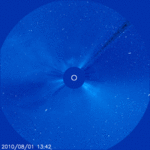Space
This week will include the peak evenings for the annual Perseid meteor shower. Although sky watchers have already seen a few exciting fireballs already, August 12 and 13 are expected to be the primary nights for viewing.And this year, there will be an exciting pre-showing of planetary alignment in the west with Mars, Venus, and Saturn formed in a close triumvirate, and the crescent moon and Mercury a few clicks away (view a sky map). Once this special arrangement has set around 10 pm--which includes the Moon this year, so dark viewing should be optimal!--then the main…

A group of researchers mimicked the surface of the Moon in their basement and concluded that it was always inherently dry.
They used an ion beam accelerator underground at Los Alamos National Laboratory to simulate solar winds on the surface of the Moon and their table-top simulation was able to help formulate an analysis of chlorine isotopic ratios in lunar rock samples that seem to indicate that the Moon never had water of its own.
Many believe that the Moon formed when a large object collided with Earth early in its formative stages, leaving behind a blob of material that became trapped in…
I am often asked questions about my musical picosatellite, Project Calliope. Easy questions have concrete answers. "What are your sensors?": I-CubeX magnetic, thermal, light. "What magnetic field is expected?": ."How are you going to distribute the tracks?": as free remixable MIDI files via web.
Others are either vague or awkward. "When will the satellite be done?": obviously 'by launch'. "What will it sound like?": whatever the musician wants. "What's your downlink bandwidth?" I'm still working on the radio parts.
"I don't know yet" is a scientist's favorite phrase. It means we're in motion…

This morning a more unique solar event occurred from the current sunspot 1092. A class C3 solar flare was unleashed from this spot along with a nearly simultaneous magnetic filament stretching mostly across the sun's northern hemisphere. The two events are likely connected by long-range magnetic fields.
The amazing and absolutely beautiful "solar tsunami" was captured in video by NASA's Solar Dynamics Observatory...
Sunspot 1092 Eruption Video (Watch Video - mpg)
along with the resulting coronal mass ejection imaged from SOHO...
Although a C3-class event represents minimal consequences on…

As I bask in media attention for my Project Calliope, it's worth noting I'm not the only Antunes getting media coverage in the space/IT world. This is one story of 'the other Antunes', and of NASA's Spacebook.
NASA created an internal social network called Spacebook. As with any social media project that makes it past its first year, it has morphed from its original intent into a compromise of various agencies. But what was its original point, its creation story?
At inception it was intended, as written in Federal Computer Week:
NASA’s Goddard Space Flight Center has developed a…

What does the ionosphere sound like? Well, our Project Calliope sonification will map the ionosphere's properties to a musical range. What you'll hear is the volume and changes of activity within it.
In some ways, sound is the best method for getting a 'big picture' of an item. Think of a large body of water. With your eyes close, you can tell the gentle lapping of a lake from the burble of a brook, the flow of a river, or the periodic crashing waves of an ocean.Our sensor data is MIDI, akin to player piano rolls or sheet music. We map sensor data to musical…
Painted green by a flashlight, astronomer Dennis Mammana of California points out Mars to onlookers on Aug. 26, 2003, when Mars was particularly close to Earth. Photo credit: Thad V'Soske via NASA Science.
Mars came particularly close to Earth back in 2003, and ever since we have been experiencing an annual email hoax convincing us that we will once again have a once-in-a-lifetime opportunity to see Mars as big as the Moon.
The cycle is happing again (view an interactive orbit map), with an expected closer encounter to happen this August. However, when you look up into the sky next month, you…
Ever want to be interviewed by big time media? I'll tell you the two secrets to getting your message out. I'll be talking about the Project Calliope extreme DIY satellite project on NPR's "All Things Considered" this Saturday (July 24), sometime after 5pm. And while I honestly have no idea what the final edit will sound like, I'm insanely pleased to have been invited.
How did I get on NPR? How can you? I will tell you the 2 secrets I've learned to getting noticed by the media.
First, here's the details on choosing a 'popular' project that the media will love.…

Just a short bit, since I'm tired after BEING INTERVIEWED BY WIRED!!!??! Not that I'd brag about being INTERVIEWED BY WIRED or anything, just thought I'd mention, in pass, that WIRED INTERVIEWED ME about Project Calliope.
Anyway, two good results of the interview (besides being interviewed by Wired!!!). First, I updated the project website, still at http://ProjectCalliope.com, to reflect the current progress and the current 'storyline'. So if you want to build a satellite, and not just read about it, that's where the story is starting to shape up. It's the same…

Up today is my 365DOA podcast, , Your Head is Jupiter. It's a new variant on a standard bit I use in classrooms, only it's much cooler because IT USES A COMPUTER! (woo!)
In it, you get to make a solar system at your desk, using your monitor as a sun. You also get to lick your monitor, if you like. Visit the link and either read the transcript or (gasp) actually listen to the podcast.
AlexTuesdays at The Satellite Diaries and Friday at The Daytime Astronomer (twitter @skyday)